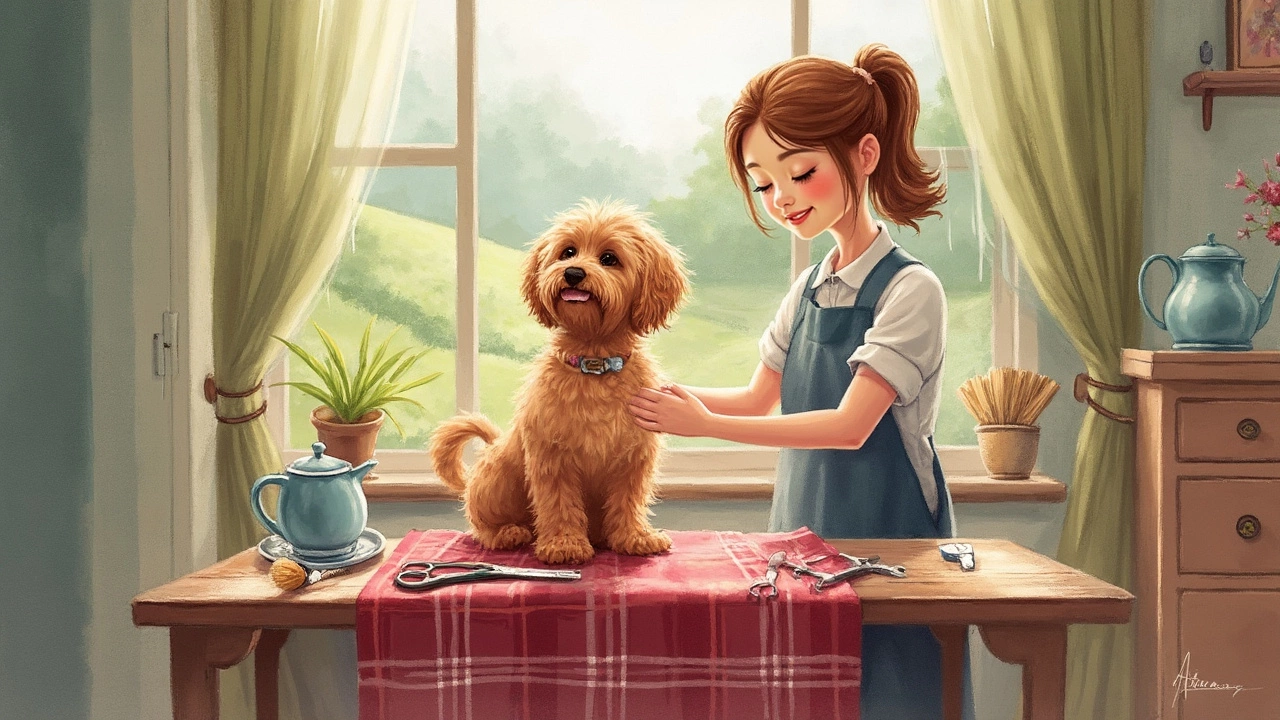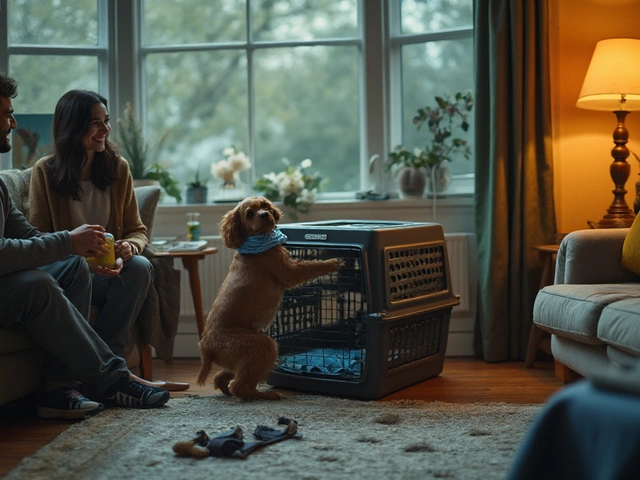You’ve got the clippers charged and the treats ready, but now comes the big question: do you cut your dog’s hair while it’s wet or dry? If you ask ten experienced groomers, you might get a mix of answers—and not just because every dog is different, but also because every coat needs something a little special.
Wet hair looks neater, but here’s the catch: water weighs fur down and hides the true length. Snip away at a wet coat, and you might end up shaving off more than you meant. When that fluff dries, suddenly your dog’s rocking a patchy look. On the flip side, dry hair shows you exactly what’s coming off. That’s a big reason why most at-home groomers (and plenty of pros) reach for the scissors after a thorough brush-out and blow-dry.
But it’s not completely black and white. Curly or thick double coats can be tricky—sometimes dampening those tangles makes them easier to manage, while thin or smooth fur is all about precision, which dry cutting delivers.
If you’ve got the urge to try your hand at doggy haircuts, understanding the logic behind wet vs dry trimming will save you time, stress, and possibly an embarrassing doggy fashion faux pas. Don’t worry, there are plenty of practical tricks (and rookie mistakes to sidestep) as you get started.
- Wet vs Dry Dog Hair: What's the Real Difference?
- What the Pros Do (and Why)
- Mistakes to Avoid When Trimming
- Quick Tips for Better Home Grooming
Wet vs Dry Dog Hair: What's the Real Difference?
Before you even switch on the clippers or grab the scissors, you’ve got to look at what actually happens when you cut wet versus dry dog hair. It’s not just a question of preference — each approach comes with some real physical changes to your dog’s coat and the end results.
When hair is wet, it lies flat and clumps together. This can trick you into thinking you need to cut off more to even things up. That’s why a lot of new groomers go too short with wet coats. Also, wet fur can be more slippery, so your tools might not grip hair as well. On the upside, if your dog has mats or thick curls, working with damp fur can make it easier to comb out tangles before the cut.
Now, cutting hair dry is a different ballgame. Dry fur “puffs” up and shows its natural length—so what you see is what you actually get. There’s less guessing, which is why most home groomers stick with dry cutting. Plus, you catch flyaways and uneven patches while you’re working, not after the fur dries and sticks out every which way. The only downside? Dry coats can be fluffier or static-y, which means you’ll need to keep brushing as you go.
- Dog grooming pros usually trim dry after a full wash and blow-dry—that’s the classic salon approach, especially for dogs with straight or wavy coats.
- Some breeds, like Poodles or Bichons, have coats that respond better to a slightly damp trim, especially if there are stubborn knots.
Here’s a little side-by-side for you. Check out the table below—these are the top pros and cons of each method, based on real groomer feedback (2024 Dog Groomers Trend Survey):
| Method | Best For | Pros | Cons |
|---|---|---|---|
| Wet Cut | Curly, tangled, or matted coats | Less tugging on knots Easier to detangle before cutting | Easy to cut too short Tools may slip |
| Dry Cut | Straight, fine, or short coats | Accurate length Less risk of over-trimming Less cleanup (fur not clumping) | More static May show flyaways |
If your dog is a floofy fluff-ball or a smooth-coated zoomer, knowing the real difference between wet and dry makes grooming way less stressful and way more predictable. Not every technique fits every pup, but now you’ve got the facts to make the call.
What the Pros Do (and Why)
Professional groomers have a solid game plan every time a pup hops onto their table. The first thing you’ll notice at a groomer’s salon? Everything gets brushed out before any cutting starts. Tangles and mats are way easier to spot and fix on dry hair, and if you cut through a knot when it’s wet, you might miss it and leave uneven bits behind. That’s why for most breeds, the go-to method is to dry the coat fully—even blowing it straight—before trimming.
In fact, the big brands of trimmers and scissors (think Andis, Wahl, or Oster) actually design their gear to work better on dog grooming with dry hair. Wet fur can gum up clipper blades way faster, and scissors can slip or pull, which you definitely don't want around a squirmy dog. Plus, dry hair gives a sharp, clean cut, so lines look crisp and the finished look is more balanced.
But pros don’t have a “one size fits all” rule. Here’s how they usually decide:
- Curly or long coats (like Poodles and Bichons): Washed, dried, then fluffed up with a brush before clipping. This makes every strand stand out, and the groomer gets a really even finish.
- Double-coated breeds (like Huskies and Goldens): Blow dried to loosen up undercoat, then combed and trimmed dry. Wet trimming can mat the downy fur or even damage the coat’s texture.
- Short-haired dogs (like Beagles): Rarely need much trimming, but when they do, it’s always dry—mainly for safety and accuracy.
For those curious about how often pros see accidents or unhappy results, here’s a quick rundown based on a 2023 dog grooming industry survey:
| Method | Reported Blades Getting Stuck (%) | Uneven Cut Complaints (%) |
|---|---|---|
| Wet Hair Cutting | 41 | 34 |
| Dry Hair Cutting | 9 | 11 |
The numbers don’t lie—trimming dry leads to fewer problems. Pro groomers also say that when owners cut at home, dry is safer, especially if you aren’t confident with scissors or clippers. Of course, a few specific breeds and coat conditions are exceptions, but as a basic rule, dry trumps wet for clarity and control.

Mistakes to Avoid When Trimming
Even with the best intentions, it’s easy to mess up a dog haircut, especially if you haven’t trimmed a lot of pups. Here’s where most people slip up—and how to sidestep those common blunders.
- Skipping the Brush-Out: If you don’t fully brush your dog’s coat before trimming, mats and tangles will make your clipper blades jam or skip, resulting in uneven fur. Always detangle first, no matter how short you plan to go.
- Trimming Without Checking Skin Folds: Dogs like pugs, bulldogs, and even some Labs hide loose skin folds. If you don’t check for those, you risk nicking the skin. Gently pull the skin tight as you go.
- Guessing Instead of Using Guards: Most clippers come with guards. Skipping them is the fast track to a bad cut or bald patch. Use the right size guard for the hair length you want.
- Clipping Dirty or Wet Fur (With the Wrong Tools): Mud, debris, or even shampoo residue makes clippers struggle, and wet fur can clog blades or lead to uneven results unless you’re using shears meant for wet hair. If you use clippers, always work on a clean, dry coat.
- Cutting Too Close in Sensitive Areas: Areas like paws, face, and belly have thinner skin. It’s safer to use scissors with rounded tips or special trimmer attachments to avoid accidents.
A big problem is cutting too much, too soon. People often snip a chunk off, thinking it’ll look better dry—only to panic when the fluff springs up half an inch higher than expected. As a rule: always cut less than you think you need, then check before you go shorter.
A quick look at some numbers sheds more light. According to a 2023 survey by the American Kennel Club:
| Common Trimming Mistake | % of Dog Owners Reporting This |
|---|---|
| Uneven fur from skipping brushing | 43% |
| Skin nicks or irritation | 31% |
| Cutting too short | 27% |
| Clipper blades clogging | 18% |
It pays off to slow down, use the right tools, and keep treats close by for wiggly pups. If you ever feel unsure, check pro groomer how-to videos or ask your vet for advice about your dog’s coat type.
Quick Tips for Better Home Grooming
If you want a stress-free trim for your pup, it pays to have a plan. Here’s what helps people get salon-level results without the fuss or mess:
- dog grooming tools make a difference. Buy a sharp pair of grooming scissors, and if your dog has a thick coat, invest in clippers suited for pets—not old hair clippers from your bathroom drawer.
- Wash and brush your dog first. Mats and tangles are much easier to see when your dog’s clean, and clippers work better without dirt and oils clogging things up.
- Never cut through mats with scissors. This is how accidental cuts happen. Always use a detangling spray or gently work mats out with your fingers or a comb before you cut.
- Go slow, especially around tricky spots like feet, ears, and the tail. Most snips gone wrong happen when people rush.
- Use treats throughout. One small treat for every body part finished keeps the vibes good and your dog less likely to bolt.
Curious which breeds need trims more often? Take a look at the table below—don’t just guess, since skipping trims can mean bigger problems, like skin infections or painful tangles:
| Breed Type | Recommended Trim Frequency | Notes |
|---|---|---|
| Poodle & Doodle Mixes | Every 4-6 weeks | Coats mat quickly; regular trims required |
| Shih Tzu, Lhasa Apso | Every 6-8 weeks | Frequent trims keep hair out of eyes |
| Golden Retriever, Collie (double coat) | 2-3 times/year | Focus more on de-shedding than cutting |
| Yorkshire Terrier, Maltese | Every 6-8 weeks | Fine hair tangles up fast; regular trims help |
If the thought of scissors close to paws still makes you nervous, try using thinning shears for a softer, more forgiving look. And remember, pups pick up on nerves—so keep the mood light, use snacks, and give lots of breaks if you need to. Your dog’s haircut doesn’t have to be perfect; it just has to be safe and comfortable for both of you.





